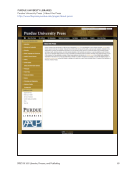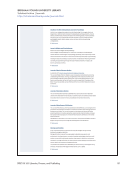2 Survey Results: Executive Summary
Executive Summary
Introduction
Many Association of Research Libraries (ARL) members have robust and long-standing publishing
activities, often in collaboration with or running parallel to the press of the larger institutional entity. As
reported in the Association of American University Presses (AAUP) 2015–2016 annual report, 30 AAUP
member presses are in libraries. Eighty-one institutions are both ARL and AAUP members, and at 21 of
those institutions, the press reports to the library. Other libraries—including Amherst College Press and
the University of Cincinnati Press—launched new presses within libraries. Most of the 123 ARL member
libraries are engaged in publishing or publishing support activities such as hosting digital publications,
administering open access publishing systems, creating open educational resources, providing editorial
services, or participating on scholarly advisory boards.
To address the critical concerns and opportunities available for libraries, presses, and
publishing, in 2016, AAUP, ARL, and the Coalition for Networked Information (CNI) hosted the first
Publishers Reporting to Libraries Summit to share knowledge and develop best practices for library-press
partnerships. In 2015, the Association of College and Research Libraries (ACRL) published Getting the
Word Out: Academic Libraries as Scholarly Publishers. Also in 2015, the National Endowment for the
Humanities and Andrew W. Mellon Foundation announced the inaugural grants for the Humanities Open
Book Program grants for bringing out of print university press books back to life digitally. The Library
Publishing Coalition (LPC) started several years prior, and successfully holds an annual meeting to assess
the variety and types of activities underway in library publishing. Further, LPC conducts an annual survey
that addresses an expanding array of publishing activities and the organizational structure for publishing
in libraries. The Coalition offers an inclusive definition of library publishing that aids in framing
discussions on libraries and publishing:
“The LPC defines library publishing as the set of activities led by college and university libraries
to support the creation, dissemination, and curation of scholarly, creative, and/or educational
works. Generally, library publishing requires a production process, presents original work not
previously made available, and applies a level of certification to the content published, whether
through peer review or extension of the institutional brand. Based on core library values, and
building on the traditional skills of librarians, it is distinguished from other publishing fields by
a preference for Open Access dissemination as well as a willingness to embrace informal and
experimental forms of scholarly communication and to challenge the status quo.”1
The findings from this survey complement the ongoing work of LPC, ARL, and AAUP on libraries
and publishing to inform on the expansive breadth of practice taking place at the intersection of research
libraries, presses, and publishing. By investigating ARL institutional landscapes and practices as they
Executive Summary
Introduction
Many Association of Research Libraries (ARL) members have robust and long-standing publishing
activities, often in collaboration with or running parallel to the press of the larger institutional entity. As
reported in the Association of American University Presses (AAUP) 2015–2016 annual report, 30 AAUP
member presses are in libraries. Eighty-one institutions are both ARL and AAUP members, and at 21 of
those institutions, the press reports to the library. Other libraries—including Amherst College Press and
the University of Cincinnati Press—launched new presses within libraries. Most of the 123 ARL member
libraries are engaged in publishing or publishing support activities such as hosting digital publications,
administering open access publishing systems, creating open educational resources, providing editorial
services, or participating on scholarly advisory boards.
To address the critical concerns and opportunities available for libraries, presses, and
publishing, in 2016, AAUP, ARL, and the Coalition for Networked Information (CNI) hosted the first
Publishers Reporting to Libraries Summit to share knowledge and develop best practices for library-press
partnerships. In 2015, the Association of College and Research Libraries (ACRL) published Getting the
Word Out: Academic Libraries as Scholarly Publishers. Also in 2015, the National Endowment for the
Humanities and Andrew W. Mellon Foundation announced the inaugural grants for the Humanities Open
Book Program grants for bringing out of print university press books back to life digitally. The Library
Publishing Coalition (LPC) started several years prior, and successfully holds an annual meeting to assess
the variety and types of activities underway in library publishing. Further, LPC conducts an annual survey
that addresses an expanding array of publishing activities and the organizational structure for publishing
in libraries. The Coalition offers an inclusive definition of library publishing that aids in framing
discussions on libraries and publishing:
“The LPC defines library publishing as the set of activities led by college and university libraries
to support the creation, dissemination, and curation of scholarly, creative, and/or educational
works. Generally, library publishing requires a production process, presents original work not
previously made available, and applies a level of certification to the content published, whether
through peer review or extension of the institutional brand. Based on core library values, and
building on the traditional skills of librarians, it is distinguished from other publishing fields by
a preference for Open Access dissemination as well as a willingness to embrace informal and
experimental forms of scholarly communication and to challenge the status quo.”1
The findings from this survey complement the ongoing work of LPC, ARL, and AAUP on libraries
and publishing to inform on the expansive breadth of practice taking place at the intersection of research
libraries, presses, and publishing. By investigating ARL institutional landscapes and practices as they



















































































































































































